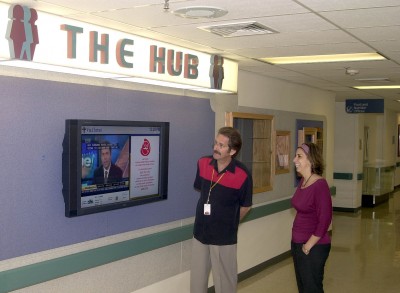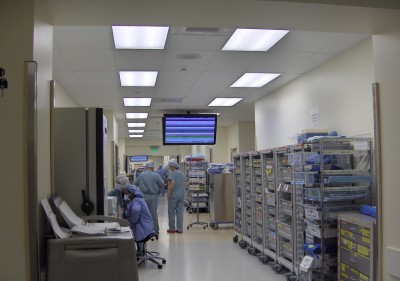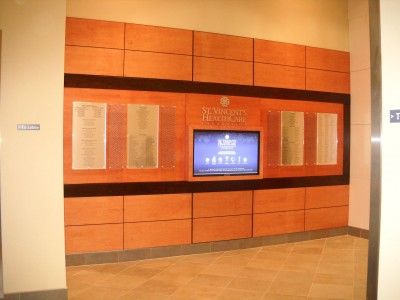Communications benefits
In many ways, digital signage in the health-care sector is responding to growing needs for the cost-effective, innovative, efficient provision of information.

It is becoming more common for hospital visitors and patients to be informed and entertained through dynamic displays. Photo courtesy Rise Display
“Wall space is precious and health-care providers don’t want to clutter it with countless posters, plaques and banners,” says Ryan Cahoy, managing director at Rise Display, a Toronto-based provider of displays, web-based content management and supporting services. “Digital signage can present more messages and information with less wall space, in a more modern and interesting way.”
The displays can be used to reinforce and amplify key messages in a health-care setting, increase awareness of department activities, improve wayfinding, promote lectures or other events, increase traffic to web-based health-care resources and reduce costs related to printing, distributing, posting and removing notices.
“Digital signage has shown value to employees who are always moving around the large facilities, rarely in one place for very long,” says Paul Flanigan, VP of content strategy for Saddle Ranch Digital, which plans networks and creates content. “Schedules change often, so up-to-the-minute information is useful to everyone. It provides tremendous benefits, as everyone knows where to look to stay informed.”

A digital signage network can tap into hospitals’ existing systems to provide information at the most relevant times and locations. Photo courtesy Omnivex
Policies and procedures can be disseminated, news items can be announced (such as new staff hires) and patrons and volunteers can be given recognition, all with greater speed and flexibility than before, using today’s content management systems.
“Dynamic signage is no longer new or especially challenging,” says an information technology (IT) project leader at one hospital, who prefers to remain anonymous. “Having it work for the facility is the key. The processes for creating and approving content are very important.”
Interactivity is also becoming more common. Digital wayfinding systems, especially can use software to generate written and visual directions to help visitors find their way to their destination.
“A health-service facility can be an intimidating and stressful environment,” says Four Winds’ Rathbun. “Clear messaging via digital signage can improve the experience by making navigation easier.”
Advertising opportunities
It is also possible for digital signage to provide new revenue through advertising. The Canadian Health Media Network (CHMN) is an example of this trend, the result of collaboration between various digital out-of-home (DOOH) networks reaching waiting rooms in family and group health centres, hospitals, multi-practice medical centres and primary care facilities, as well as medical laboratories and x-ray and ultrasound clinics. As a marketing affiliation between these facilities, it has been able to offer properly measured and validated demographics to advertising buyers.
While ad-based digital signage networks are more commonly found in commercial settings, Northern Sky Research (NSR) expects global ad revenues from health-care networks will grow to 13 per cent of the total by 2019.
“With the required metrics in place, the health-care sector should exhibit steady DOOH advertising growth potential,” says Prashant Butani, formerly a senior analyst at NSR and now a client manager at Cable&Wireless Worldwide, a telecommunications service provider.
Lyle Bunn is strategy architect for Bunn Co., based in Brighton, Ont., providing analysis, consulting and education for the digital signage industry. For more information, visit www.lylebunn.com.






